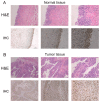The expression and clinical significance of ZBTB7 in transitional cell carcinoma of the bladder
- PMID: 29085492
- PMCID: PMC5649710
- DOI: 10.3892/ol.2017.6814
The expression and clinical significance of ZBTB7 in transitional cell carcinoma of the bladder
Abstract
Zinc finger and BTB domain containing 7A (ZBTB7) is a ZBTB protein family member of transcriptional repressors that serves a critical role in cell transformation and malignancy. However, the association between ZBTB7 expression in bladder cancer tissues and the prognosis of patients remains unclear. The aim of the current study was to detect the expression of ZBTB7 in transitional cell carcinoma (TCC) of the bladder and normal bladder mucous tissues to evaluate the diagnostic and prognostic value of ZBTB7 in TCC of the bladder. A total of 100 TCC specimens were analyzed and the expression of ZBTB7 mRNA was examined via reverse transcription-quantitative polymerase chain reaction. The expression of ZBTB7 protein was examined by western blotting and immunohistochemistry. The association between ZBTB7 expression and the clinical prognosis of patients from the TCGA database was analyzed. High expression of ZBTB7 mRNA and protein in TCC tissue was detected and TCC expression was significantly higher in TCC tissue than in normal bladder mucous tissues (P<0.05). Furthermore, ZBTB7 expression was associated with recurrence, a larger tumor size and higher tumor grade. In terms of overall and recurrence-free survival, the group expressing high levels of ZBTB7 exhibited lower overall and recurrence-free survival compared with the low ZBTB7 expression group, although these differences were not statistically significant. Therefore, ZBTB7 may be important in the initiation and progression of TCC.
Keywords: ZBTB7; prognosis; survival; transitional cell carcinoma of the bladder.
Figures




References
-
- Geng J, Fan J, Ouyang Q, Zhang X, Zhang X, Yu J, Xu Z, Li Q, Yao X, Liu X, Zheng J. Loss of PPM1A expression enhances invasion and the epithelial-to-mesenchymal transition in bladder cancer by activating the TGF-β/Smad signaling pathway. Oncotarget. 2014;5:5700–5711. doi: 10.18632/oncotarget.2144. - DOI - PMC - PubMed
LinkOut - more resources
Full Text Sources
Other Literature Sources
